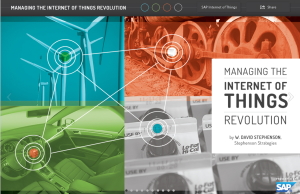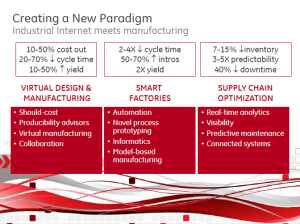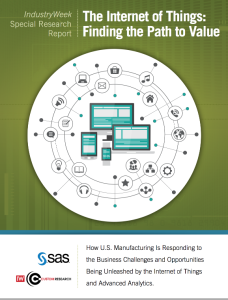What if you’re interested in the Internet of Things, but are a little scared of making a major commitment and making major expenditures until you build your familiarity level and start to enjoy some tangible results?
That concern is understandable, especially when prognosticators such as I emphasize what a transformational impact the IoT will have on every aspect of your operations and strategy.
So where to begin?
I’ll speak on this issue at SAP’s IoT 2016 Conference, Feb. 16-19, in Las Vegas, and hope you can attend. But, if not, or if a teaser might convince you to make the plunge, here’s a summary of my major points, which I hope will motivate you to act sooner, rather than later!
 This is an issue that I first visited with my “Managing the Internet of Things Revolution” e-guide to IoT strategy for C-level executives, which I wrote in 2014 for SAP, and which has been successful enough that they’ve translated it into eight languages.
This is an issue that I first visited with my “Managing the Internet of Things Revolution” e-guide to IoT strategy for C-level executives, which I wrote in 2014 for SAP, and which has been successful enough that they’ve translated it into eight languages.
I suggested that the best reason to begin now on creating and executing an IoT strategy was that a lot of the requisite tools for an IoT strategy were also critical to optimize your current operations:
- invest now in analytical tools (such as SAP’s HANA!), so that you can make sense of the rapidly-expanding amount of data (especially unstructured data) that you are already collecting, with new benefits including predictive analytics that allow you to better predict the future.
- even before capital equipment is redesigned to incorporate sensors that will yield 24/7 real-time data on their operations and status, consider add-on sensors where available, so you can take the guesswork out of operations.
- where possible, process sensor data “at the edge,” so that only the relevant data will be conveyed to your processing hub, reducing storage and central processing demands.
- develop or contract for cloud storage, to handle vastly increased data.

GE Brilliant Factory benefits
As I’ll explain my speech, even without launching any major IoT projects such as product redesign or converting products into services, initial IoT projects such as these will dramatically boost your profits and efficiency by allowing unprecedented precision in operations. I’ll emphasize the example of GE, whose “Brilliant Factory” initiative is aimed at increasing both its own manufacturing efficiency and its customers’ as well. They make a modest, but astonishing claim:
“GE estimates that a 1% improvement in its productivity across its global manufacturing base translates to $500 million in annual savings. Worldwide, GE thinks a 1% improvement in industrial productivity could add $10 trillion to $15 trillion to worldwide GDP over the next 15 years.”
Remember: that’s not exploiting the full potential of the IoT, but simply using it to boost operating efficiency. I see this as bringing about an era of “Precision Manufacturing,” because everyone who needs real-time data about the assembly line and production machinery will be able to share it instantly — including not only all departments within your company but also your supply chain and your distribution network.
In many cases, resupply will be automatic, through M2M processes where data from the assembly line will automatically trigger supply re-orders (and may lead to reshoring of jobs, because the advantages of true “just-in-time” delivery of parts from a supplier located a few miles away will outweigh the benefits of using one on the other side of the world, where delivery times are measured in weeks). Instead of the current linear progression from supply chain to factory floor to distribution network, we’ll have a continuous loop uniting all of those components, with real-time IoT data as the “hub.”
Again, without making a full-fledged commitment to the IoT, another benefit that I’ll detail is how you’ll be able to dramatically improve workplace safety, especially inherently chaotic and fast-changing worksites such as construction projects and harbors, whose common elements include unpredictable schedules, many companies and contractors, many workers, and many vehicles — a recipe for disaster given current conditions! However, the combination of simply putting location sensors on the equipment, vehicle, and people can radically decrease the risk. For example, in Dubai — home to 25% of all construction cranes in the world — SAP partnered with a worldwide leader in construction site safety, SK Solutions. Sensors are located on machinery throughout every site, reporting real-time details about every activity: machinery’s position, movement, weight, and inertia and critical data from other sources (as with the GE Durathon factory’s use of weather data), including wind speed and direction, temperature, and more. Managers can detect potential collisions, and an auto-pilot makes instant adjustments to eliminate operator errors. “The information is delivered on dashboards and mobile devices, visualized with live 3-D images with customizable views.”
As I’ll tell the conference attendees,
“Equally incredible is the change at the Port of Hamburg, Germany’s biggest port, which must juggle 9 million containers and 12,000 vessels a year, not to mention a huge number of trucks and trains. You can imagine the potential for snarls and accidents. Since installing HANA, all of these components, including the drivers and other operators, are linked in real time. Average waiting time for each truckload has been cut 5 minutes, and there are 5,000 fewer truck hours daily. The coordination has gotten so precise that, if a trucker will be held up by a bridge opening, the nearby coffee shop will send a discount coupon to his iPad.”
I’ll conclude by mentioning a couple of the long-term components of an IoT strategy, such as redesigning products so that they can be controlled by apps and/or feedback constant information on their status, and considering whether to market products instead as services, where the customer only pays for the products when they’re actually being used, and creating optional data services that customers may choose to buy because they’ll allow the customer to optimize operating efficiency.
But the latter are the long-term challenges and benefits. For now, I’ll tell the audience that the important thing is to begin now investing in the analytical tools and sensors that will help them boost efficiency.
Hope you can be there!
Oh yeah. Why get started on your IoT strategy now, rather than wait a few more years? Last year, former Cisco Chairman John Chambers said that 40% of the companies attending a recent seminar wouldn’t survive in a “meaningful way” within 10 years if they don’t begin now to embrace the IoT. Sobering, huh?
 The survey, “The Internet of Things: Finding the Path to Value,” (underwritten by SAS) was conducted late last year. 478 companies completed it. The survey’s major finding was that:
The survey, “The Internet of Things: Finding the Path to Value,” (underwritten by SAS) was conducted late last year. 478 companies completed it. The survey’s major finding was that: This is an issue that I first visited with my “
This is an issue that I first visited with my “
